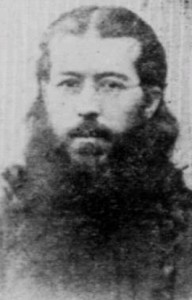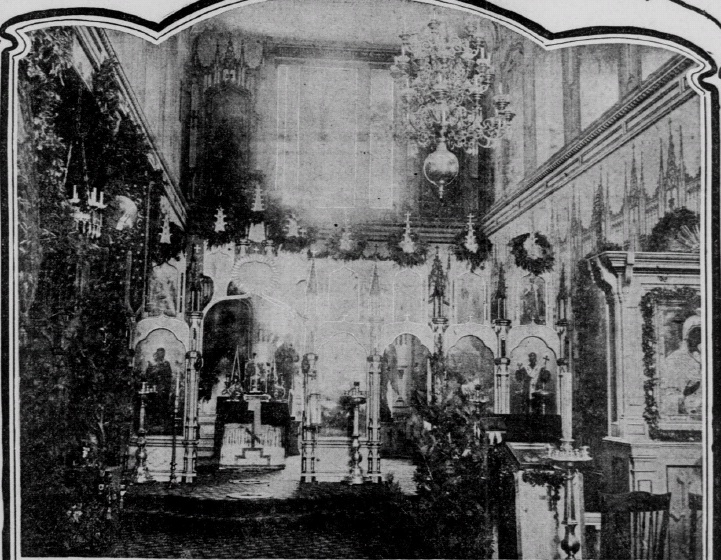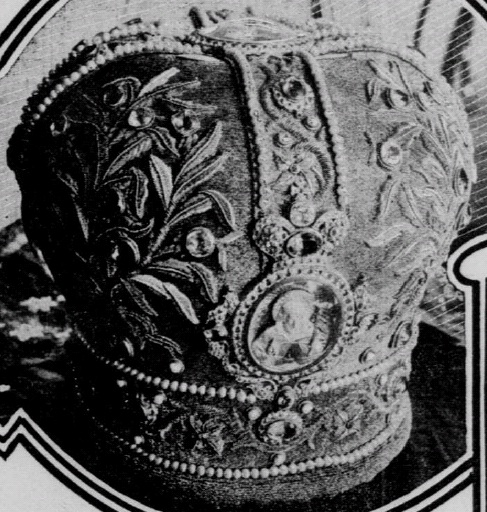Editor’s note: On April 22, 1900, the San Francisco Call published a full-page spread on Orthodoxy in America. The author, Sarah Comstock, visited San Francisco’s Holy Trinity Cathedral and interviewed the cathedral dean, Fr. Sebastian Dabovich. The resulting article (below) was accompanied by several photos, some of which I have reproduced here.
It has advanced quietly enough. Churches and missions have been established here and there, and without the blowing of trumpets. Now, at the top of all the years’ climbing, the Most Holy Synod in St. Petersburg creates the diocese of North America, names a Bishop therefore and chooses San Francisco as the see city. This is the largest diocese in the world. And it was only so long ago as 1759, I believe Mr. Inkersley turned aside from his seal skinning long enough to set up the first cross ever planted by orthodox hands on this side of the Pacific.
“Most Rev. Tikhon, Bishop of the Aleutian Islands and North America,” is the whole of it. A man of no more than 35 years claims the title. Rev. Tikhon of San Francisco is the Bishop over all our continent.
Over in the northern part of our city live the Greeks and the Russians and the Slavs who trudge hills up or hills down to their orthodox service. There are so many of them that little Trinity Cathedral nigh overflows. In the days to come there will be such a cathedral built here as the great cities of the mother land have built. So much the 600 members are glad of and proud of, but they do not wait until then to worship. They are a hard-handed, bleakly clad congregation for the most part, who drudge for the six days that it is permitted to drudge, and on the seventh day they stand for two hours in reverence that will be no deeper when the splendor of the Orient is about them.
Last Sunday I saw them come in ones and twos and threes of them, and some came in the weariness of sagging muscles and some brought curious, restless little children because they must bring them or forego the worship of people together. Great, vigorous men were there, such and so many as I have not seen before inside church walls on a Sunday when the green things outside are newly green and the ceiling of the park is of a color with the blue, far away glimpses where north-bound streets come to their end. From first to last these people stand while they watch green-robed priests moving slowly, intricately through the royal gates; while they listen to the voices that chant without accompaniment as it is written.
Trinity Cathedral is an adapted house. From without it gives no promise of Oriental gorgeousness. Within is the color spilling from high windows and the gleam of rare ikons, gold draped, and warmth of paintings. The monotony solemn sound and the heavy fragrat from swaying censers and the presence faith make all things drifting.
In the midst of the priests and deacons I saw the Bishop – the newly famous man. He stood with his back to the people, and for a time I knew only that his robe was splendidly green and gold like the rest, only more splendid, and that the miter was beautiful with turquoises, and that beneath it flowed long locks of yellow hair that may or may not indicate something by its fineness. I saw that the form of the man was magnificent enough to belong to the savage past or the enlightened future.
So much I watched during long and ceaseless music, all of which was a mere accompaniment to the organ tones of the big faced proto deacon, who is known to people and clergy as “the man of the strong voice.” Now and again I caught a glimpse of the Bishop’s hand extended for the kisses of baby acolytes, and I thought the hand was like a woman’s. It contradicted the power of the figure. And I waited to see the face.
When at last the man, the teacher, the priest turned, it was borne in upon me that there was no contradiction after all. The candles had been given to him. The signs he made with them were mechanical. But while I understood not one word of his, I looked into his face and I felt that we were being blessed. I am sure that he is gentle as a woman and strong as a man, and that is why he has been chosen for a spiritual guide to both.
The race of him is written in every feature. Dully fair in coloring as Russians are; wide and square of countenance as the Russians are; clumsy of feature as the Russians are. But the expression is one that claims no race, for it is great enough to be universal.
Father Sebastian Dabovich, who is the Bishop’s tireless assistant in charge of Trinity Cathedral, has outlined the Bishop’s life for me. It seems that he was the son of a parish priest in the Russian province of Pskov, and in the steps of his narrowly bound father he went about doing good. Then there was a reach toward bigger things and the young Tikhon was sent away to St. Petersburg, where the world is a wider one than in the province of Pskov. The boy liked to learn and he studied well, and at last he came to teach others, for he was made a professor of theology in the Seminary of Kazan. In 1892 came a presidency at the Seminary of Cholm, and 1897 saw his consecration. He was made Bishop of Lublin, assistant to the Bishop of Warsaw.
From that year on he has grown greater in the eyes of the church. He was promoted to the independent diocese of Alaska in 1898, and then began his American labors. It was not altogether easy to pull up roots. Russia is his home and the church’s home, and Alaska gives dreary welcome to strangers. But the seal of the work was upon him, and he knew the joy of sacrifice.
He came to the field where those first eight missionaries had labored. It was in 1794 that they cut a way through pathless Siberia and struggled to achievement. This achievement was the conversion of the Aleuts. In the time that followed, chapels were built. They were simple affairs, but they held together the worshipers. The Indians came regularly to service and joined the church. To-day a priest on the Aleutian Islands has little to do in the way of conversion. The ground is won and must be settled.
One church, that of Sitka, has been adorned. Its royal gates are famous. Its ikons are rich. Its peal of bells is music. This cathedral will hold the first place for beauty in the Greek Church of America until the San Francisco cathedral is built.
Among the meek Aleuts Bishop Tikhon labored in churches and schools. He saw the little Indians making themselves awkward in the clothes of civilization and he was happy as a father. But he was not satisfied with this work alone. Alaskan affairs were in smooth running order, hence he helped the church extend. It is reaching to all parts of our land now.
His new title is the outward climax of his labors. The American diocese, being so large, has been divided into four deaneries, Father Sebastian tells me: one in the Eastern States, one in the Western and two in Alaska. “The Bishop is to be assisted in the administration by a consistory,” he says. “This sits with him in San Francisco. There are thirty priests in the diocese, four deacons, two sub-deacons and twenty-five teachers and parish clerks.
“We have strong parishes in Pennsylvania and New York. We have one in Portland, in Seattle, in Jackson, California, and we hope to build in Los Angeles before long.”
Already there are treasures here that will go to make beautiful the new cathedral. An ikon of Christ is one, and one of the Mother and Child is another. The orthodox church differs from the Roman in its view of the Mother. In this point it comes nearer to the Anglican branch, while on the other hand, its elaborate service is more like the Roman.
Another treasure kept at Trinity Cathedral is a miter worn by the Bishop on great days. It is set with jewels of every color and is valued at $2000. It is the finest in America. Such is the wealth of the church in Europe that there are miters there worth as much as $50,000.
The wealth of adornment, the dignity of service, the devotion of worship have established themselves in our land. How much stronger hold they will gain – who knows?



